Meats
How do you know if it's fresh?
You are at the supermarket, grocery store, or health food store and you are picking you favorite meat for the next few days. How do you know if you've gotten the freshest, best available?
This can be a tough shopping experience. Many of the items you chose are prepackaged and that packaging (even the lighting) can throw you off and cause you to make a less than palatable purchase.
Also, how do you know if that "brown" meat is really bad? If it was why would the butcher be allowed to sell it? What about fish; how can you tell if it's fresh or many days old? And what about shrimp, crab, and mussels?
This article will discuss the many types of meat (beef, pork, lamb, chicken, fish, shell-fish, and bivalves) and how to select each type for best taste and nutritional value.
Beef Cuts
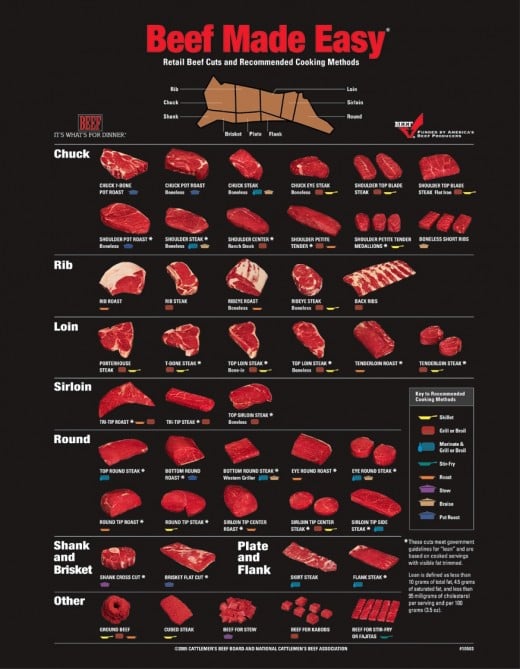
Beef
Beef is defined as any meat that comes from domesticated cows.
Beef should be red in color (ideally) and have a slim layer of fat around the outside (depending on the cut) and slight marbling (thin strips of fat running through the meat).
There are many cuts of beef. The most tender being the loin and the toughest typically called the flank or skirt. With proper cooking this is no such thing as a bad cut of beef. The most tender cuts simply mean that the beef remains tender with short cooking times. "Bad" beef is meat that takes longer to cook to reach the same level of tenderness.
Lately there has been a lot of talk about the superior taste of grass fed beef over grain fed. This is very likely true. After all, a cow did not roam the plains in prehistory eating out of buckets filled with oats. No, they are ruminants and they are designed (by G_d or nature; your choice) to eat grass.
Chart
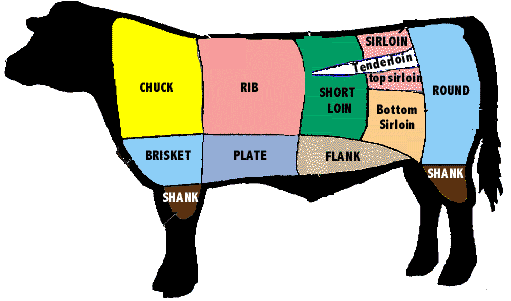
Chart Cuts
Looking at the chart at the right you'll notice that the best cuts are just forward of the rump. This includes the tenderloin (light pink), sirloin (darker pink above tenderloin), and top sirloin (just below the tenderloin (darker pink below tenderloin). From there the short-loin, rib, and round (green, beige, and blue). Then chuck and brisket (yellow and light blue). Followed by the flank and plate (AKA skirt) which are light brown and violet followed finally by the shanks (dark brown).
Picking the Best Beef
Beef should be bright red to red in color. Have a thin layer of fat around it and be marbled slightly with thin layers of fat. Any brown areas on the beef should be viewed with suspicion though it is highly likely that brown beef isn't old; just improperly stored.
In the modern grocery spotting perfect beef can be a challenge. Lighting in at the meat counter is purposely shifted toward the red to make it look more inviting. Grocery chains also like to put bright green fake grass nearby simply to make the reds even redder.
Also, because most meat is now packaged in foam trays with clear plastic covering it's impossible to really feel the meat or look at all sides of it. This is where trust in your grocer is really important. If you get a cut home and realize it isn't what you wanted or is not as advertised take it back. It's your money and you should get what you pay for.
Despite all of the advances made in the meat industry toward better tenderizing and the "perfect cut" a tough steak will occasionally get through the process and make it to your kitchen. Again, take it back if it's not up to your standards.
You could also buy directly from the butcher counter. At least this way you get a better look at what you are buying, but even then there's no assurance that you are getting the great cut that it looks like. Once again take it back if it's not up to your standards.
Hand Test
Click thumbnail to view full-size
Cooking...Hand Test
There are four levels of "done-ness" with steak. These are rare, medium rare, medium, and well done. The best way to tell if your beef has reached one of these stages is by touch. If rare you should be able to press on the meat and feel a particular amount of give. The more well done the less give.
To replicate these use your right or left hand and press on the pad below your thumb with the other finger. If you touch your index finger with your thumb and then press on the pad of the palm that would be the same feel as rare.
Touch your thumb to your middle finger and the pad on your palm represents medium-rare. (see photo above)
Touch your ring finger with your thumb and the resistance on the pad is what medium should feel like.
Finally, touch the little finger with your thumb and the pad below your thumb at the palm would represent well-done.
Storing, Thawing, and Cooking Beef
Frozen: If you are buying frozen beef let it thaw in your refrigerator for twenty-four (24) hours before putting it on the counter to thaw completely. This will prevent ice crystals from damaging the meat. If you thaw too fast you can actually damage the connective tissue in the cut. Of course if this is what you want to do, then by all means do a rapid thaw.
To achieve a rapid thaw put your packaged beef in a tub of cold (not hot or warm) water. Check often. You do not want it to sit at room temperature unless you are ready to cook.
You should always cook your beef starting from room temperature.
Desired Temperature: These days the Department of Agriculture recommends cooking to 160º F. I think this is overkill and you certainly won't get a rare or even medium rare steak that way. Shoot for 140º F. This is the same temperature pork should be cooked to.
If you use an oven thermometer make sure the probe is directly in the middle (from top to bottom / side to side) of the cut. If you are shooting for 160º, set the probe to 158º. You'll always gain another two degrees after the meat is removed from the heat. This is due to the effect of stored heat and the need to "rest" the beef.
Rest: Any time you cook beef (or pork or lamb, etc.) you should let the meat "rest" after taking it away from the heat source. Cooking causes any fluids in the meat to rise to the surface. Letting that steak "rest" for five to ten minutes will allow those liquids to be reabsorbed by the meat and this makes for a much more tender & flavorful meal.
Marinade: A marinade does not actually tenderize the meat; instead it expands the distance between the muscle fibers giving the impression of a tenderized cut. It also helps your meat retain more moisture during cooking. Both of these are good things.
Cutting and Serving: Cutting against the grain of the meat will give the impression of a much more tender cut. For example flank and skirt steak have a very noticeable "bias" in the meat fibers. If you slice these two cuts such that you cut across the fibers you'll have a much more tender, easy to chew, cut.
Serve the meat as soon as possible after the rest period.
Brown Beef: How do grocers get away with selling "brown" ground beef or brown spotted steaks at the meat counter? Simple; it's not spoiled.
Granted spoiled beef will look brown, but so will raw beef that has been placed under too much pressure when packaged or stored. Use this to your advantage. Ask for a discount!
Pork Charts
Click thumbnail to view full-size

Pork
Pork is any meat that comes from the domesticated pig. In this country (the United States) it is acceptable to use meat from every area of the pig including the head. This is not so with beef.
Pork should be pink or near white in color (ideally) and have a slim layer of fat around the outside (depending on the cut). There is not describable marbling.
There are many different cuts of pork though not nearly as many as for beef. The most tender being the loin and the toughest typically called the side. As with beef with proper cooking there is no bad cut of pork; only improper cooking. The most tender cuts simply mean that the meat remains tender with short cooking times. "Tough" pork is a cut that takes longer to cook to reach the same amount of tenderness.
Generally speaking, pork is only slightly less tender than chicken when properly cooked.
Despite advertising claims of "the other white meat" pork is officially a red meat like beef.
Ham and Pork Servinigs
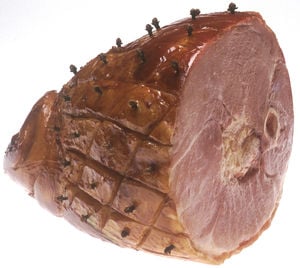
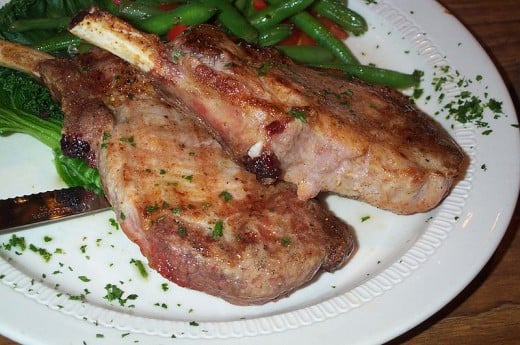
Storing, Thawing, and Cooking Pork
Click edit above to add content to this empty capsule.
Frozen: The same rules that apply to beef apply to pork. To thaw let it sit in your refrigerator for twenty-four (24) hours before putting it on the counter to thaw completely. This will prevent the rapid formation of ice crystals from ruining the meat.
You should always cook your meat from room temperature.
Desired Temperature: These days the Department of Agriculture recommends cooking to 140º F. You certainly won't get a rare or even medium rare cut that way, but you don't want to with pork. Shoot for 138º F.
As with beef, make sure the thermometer probe is directly in the middle (from top to bottom / side to side) of the cut. If you are shooting for 140º, set the probe to 138º. The meat will continue to cook for a few minutes after removal from the oven, pan, or grill.
Rest: Let the meat rest for five to ten minutes to halt the cooking process and allow the juices to return to the fibers of the meat.
Marinade: A marinade is even more important with pork since it is more completely cooked than beef.
Cutting and Serving: As with beef cutting against the grain of the meat will give the impression of a much more tender cut.
Serve the meat as soon as possible after the rest period.
"Best" Pork Marinade
1 Cup Cool Strong Coffee
|
1/2 teaspoon ground black pepper
|
|---|---|
| 6 ounces molasses by weight | 6 to 8 sprigs thyme |
| 2 Tablespoons apple cider vinegar | 1/2 teaspoon ground ginger |
| 1 Tablespoon Dijon mustard | 1 teaspoon kosher salt |
| 2 cloves garlic or 2 teaspoons crushed | 8 ounces of pork |
Pork Marinade. Marinades do not tenderize meat. They DO cause fluids to move into the spaces between the muscle fibers making the meat seem tender. Place in "zipper seal" plastic bag and remove all the air. Marinade for at least two hours.
Lamb Cuts
Click thumbnail to view full-size

Lamb, Hogget, and Mutton
Lamb is the meat of domesticated sheep. By definition meat from sheep a year or younger is lamb; older than one year with two sets of incisors and it's hogget. More than two incisors and it is mutton. Here in the United States we rarely hear the terms "hogget" or "mutton."
Typically sheep meat darkens and reddens with age. For that reason Lamb will be pink in color and hogget & mutton a darker pinkish red. Hogget and Mutton have much stronger flavors that Lamb. This has to do with maturation and a higher concentration of fatty acids.
Because Lamb is somewhat foreign fare in the United States it is rarer and thus more expensive per pound than beef, pork, chicken, and most fish.
This may be partially due to it's strong flavors as well.
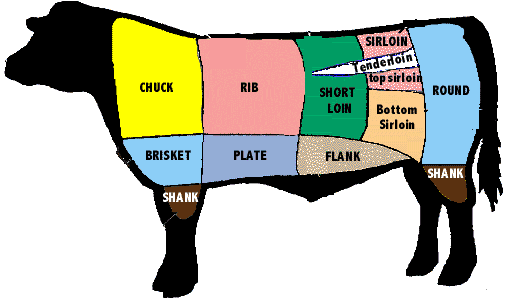
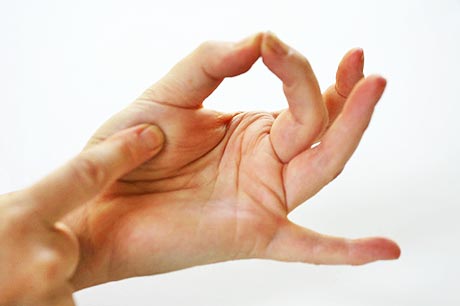
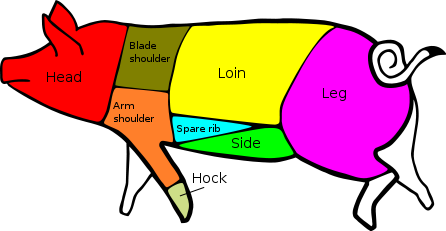
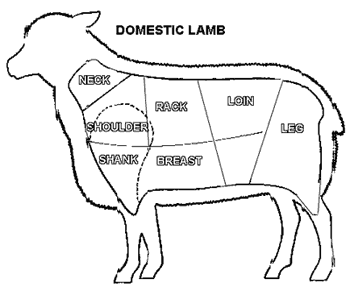

No comments:
Post a Comment